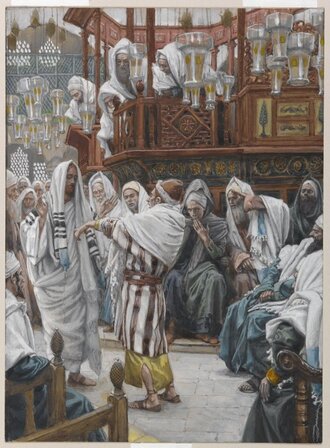|
For your study group
Hopefully at this point you have at least one other person with whom you can go over the Gospel of Mark. If you do not, no worries. It can be difficult to find someone willing to enter the long haul and go into the Scriptures prayerfully. Spending time with the reflection questions while pondering the Gospel, even if done alone, will only help draw us closer to Jesus Christ. Perhaps you’ve already been shocked by what you’ve read from Mark 1-2. If you’ve not read the Gospels from start to finish before, you might find that Jesus isn’t like you’ve imagined. Remember, Jesus is perfect. Jesus reveals us to ourselves. Jesus is both 100% God and 100% man. He is the Second Person of the Trinity Incarnate (who took on flesh). So, when we read the Gospels and see Jesus’ acts and hear him speak, we gain a glimpse into how God calls us to speak and act. That might make some uncomfortable in this week’s chapter. Take time to go through Mark 3. At the end of Chapter 2, Jesus spoke into the purpose of the Sabbath from God’s perspective. At the very beginning of Mark 3, we get an even deeper insight into the meaning of the Sabbath. Re-read Mark 3:1-6. When you’ve got more familiar with the passage, try your best to close your eyes and image being present in the synagogue on that day. Picture a worship space with pews and a stage where the Scriptures are read. Jesus enters and someone next to you has a withered hand. Jesus calls that gentleman up to the front before all present. Then, Jesus commands the man to stretch out his hand. How could he do that? It’s a withered hand! But the man obeys and is healed on the Sabbath in front of everyone. What happens to your mind and heart when you envision that moment? What would that have been like to be present? When you’ve spent time meditating in that way with Mk. 3:1-6, take a few moments of silence while recognizing that the same Jesus Christ who healed that man is the same Jesus Christ you receive on Sundays at Holy Communion. Sit with that truth for a moment of prayer. Questions for your Reflection:
Food for Thought: Two verses of Mark 3 remain puzzling for many readers: Mark 3:29 and Mark 3:31. With these two verses we have two questions: (1) Is there a sin that even Jesus “won’t” or “can’t” forgive? (2) Why does the Church maintain that Jesus is Mary’s only son if he had “brethren” (v. 31)? To help in our reflection on these important points, I am going to take two long quotes directly from Mary Healy’s commentary title “The Gospel of Mark” by the Catholic Commentary on Sacred Scripture series. On Mark 3:29 “In his encyclical on the Holy Spirit, Pope John Paul II explained that the blasphemy against the Holy Spirit ‘does not properly consist in offending against the Holy Spirit in words; it consists rather in refusal to accept the salvation which God offers to man through the Holy Spirit, working through the power of the Cross.’ It is ‘the sin committed by the person who claims to have a ‘right’ to persist in evil – in any sin at all – and who thus rejects Redemption.’ The Catechism adds: ‘There are no limits to the merc of God, but anyone who deliberately refuses to accept his mercy by repenting, rejects the forgiveness of his sins and the salvation offered by the Holy Spirit. Such hardness of heart can lead to final impenitence and eternal loss’ ([Catechism of the Catholic Church paragraph] 1864)” (Healy, The Gospel of Mark, p. 78). On Mark 3:31 “Who are the brothers and sisters of Jesus mentioned here and throughout the New Testament (John 2:12; Acts 1:41; 1 Cor 9:5; Gal 1:19)? Some commentators have contended that they refer to Jesus’ full siblings. But the ancient Church unanimously held that Mary remained a virgin throughout her life. That Mark is not referring to full siblings of Jesus is indicated by his later mention of James and Joses as sons of a different Mary (Mark 6:3; 15:40; see Matt 27:56). Moreover, the brothers’ authoritative behavior toward Jesus (Mark 3:31-32) suggests that they are older than he, although Jesus is Mary’s firstborn (Luke 2:7). Both Hebrew and Aramaic, lacking a word for ‘cousin,’ used ‘brother’ to refer to a range of kinship relationships (see Gen 13:8; 2 Kings 10:13-14; Rom 9:3). The Greek term adelphos also admitted a wider meaning than full sibling. Catholics have traditionally interpreted Jesus’ brothers to refer either to his cousins, as St. Jerome held, or to children of Joseph by an earlier marriage (see Catechism, 500)” Comments are closed.
|
AuthorFr. Jacob Bearer is a Catholic priest. He's about 6' to 6'4'' tall depending on which Convenient Store he's exiting. Although he enjoys kidney beans in chili, Fr. Jacob does not like baked beans and counts this as one of the toughest blotches on his character. He's been the administrator of SS. Edward's and Lucy's since January of 2022. Thank God for the Hatchery...this is a place where the author can share thoughts and ideas that don't quite seem right for the bulletin and won't exactly make for a homily (except for the times when the homily is posted with a sound file or used for a blog post). God bless you...and the hatchery. Archives
July 2024
Categories |

 RSS Feed
RSS Feed